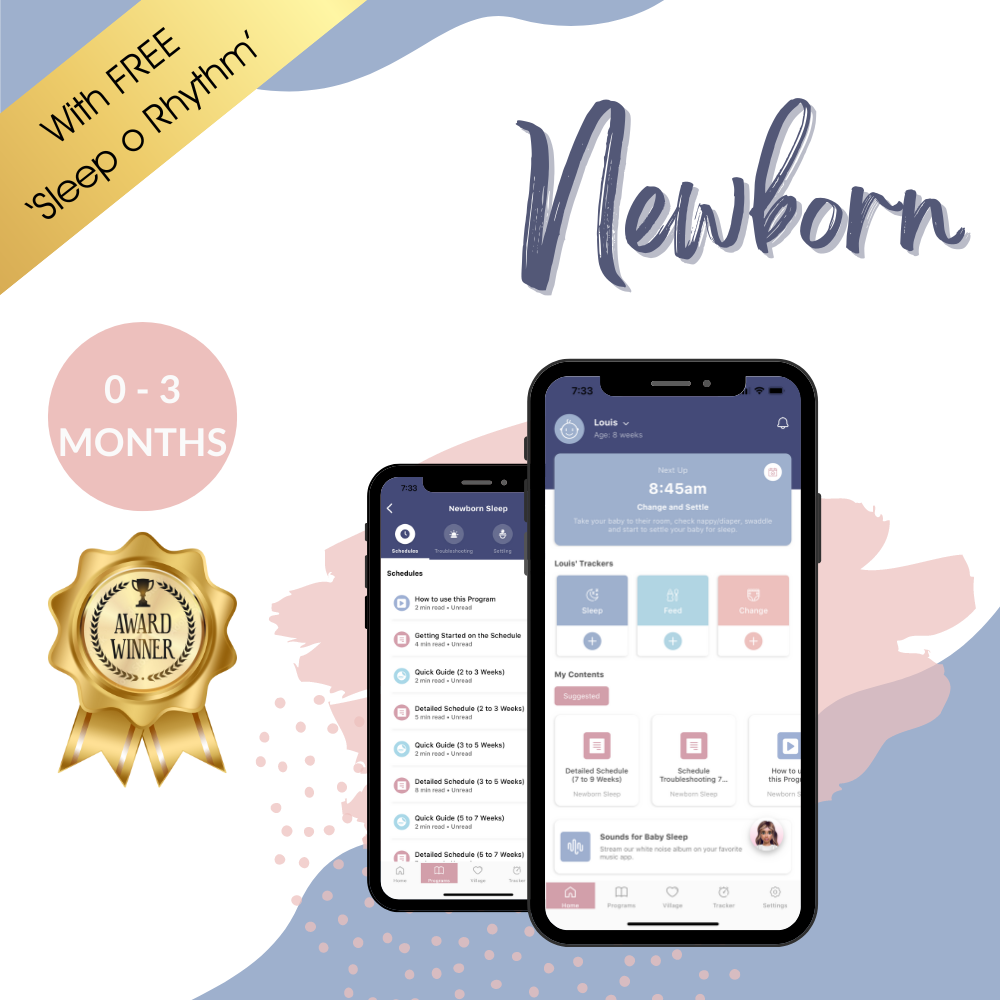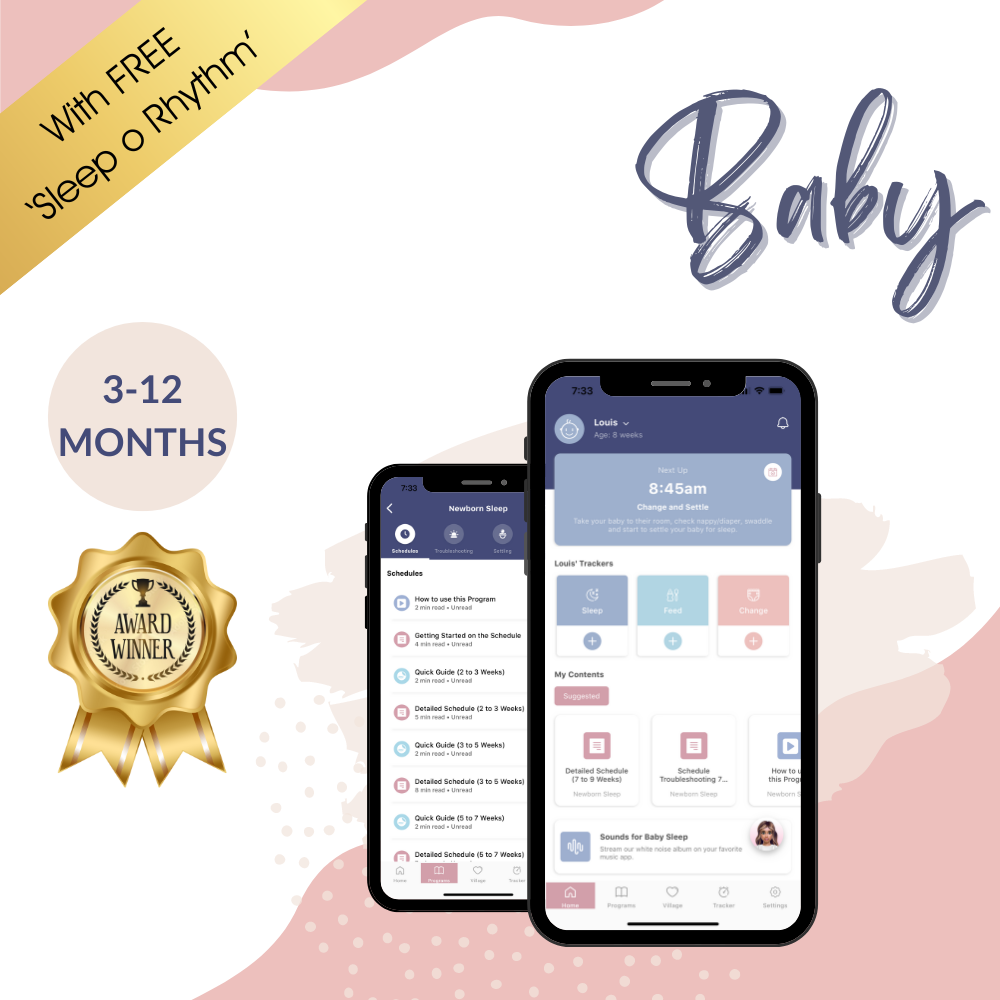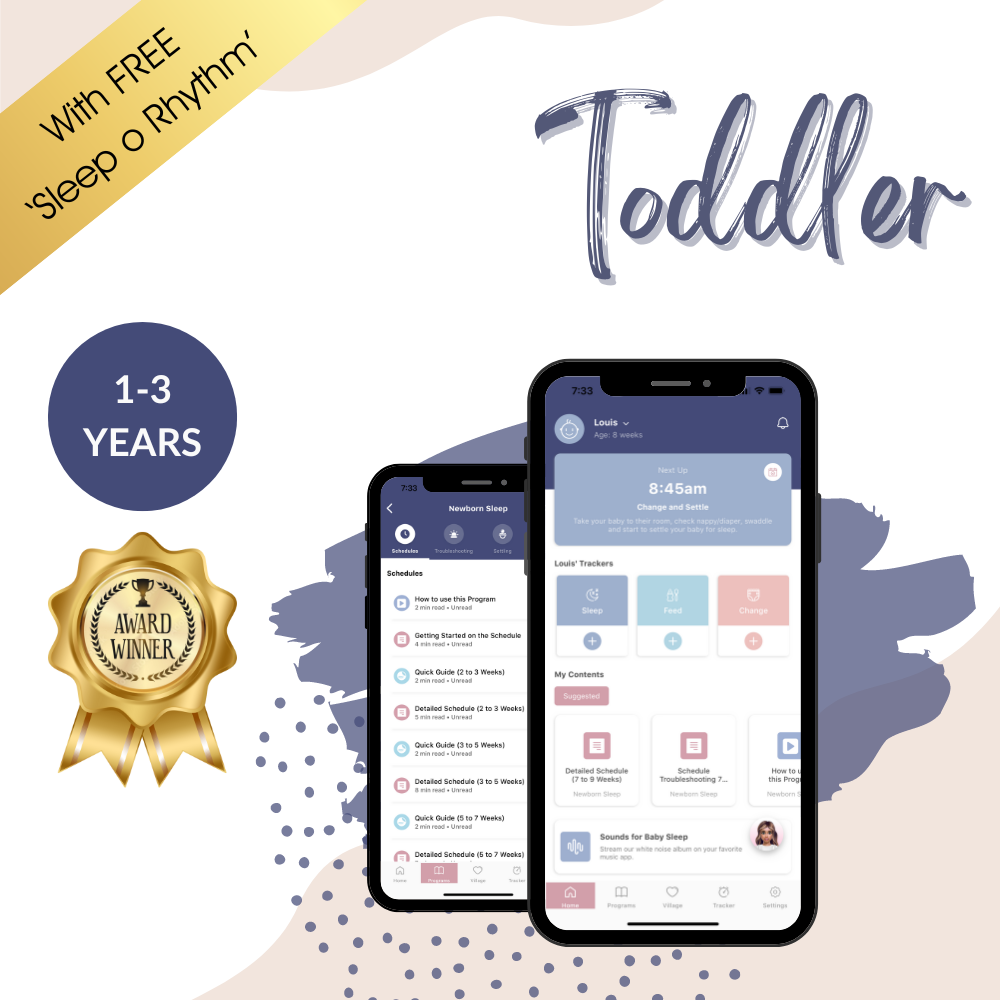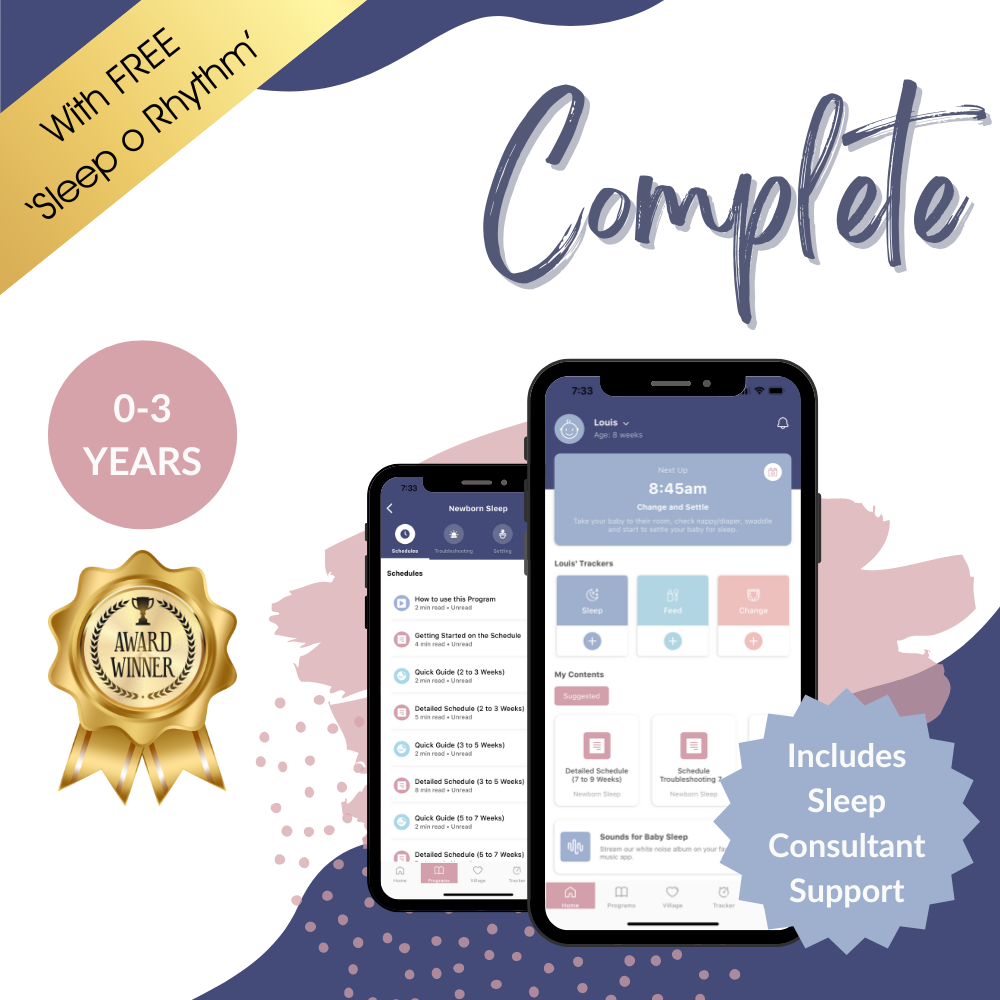
Baby sleep routines: the facts and the fallacies
Confused by baby routines? We separate myths from facts to help you understand what really works for your little one’s sleep and development.
Routines get a bad rap.
There seems to be this assumption that on a “routine” your baby is left to cry themselves to sleep, or they are only fed when it is “feed time”, or they are kept awake despite being tired. This assumption seems to stem from some archaic form of parenting, leftover from our parent’s generation or the one before, where these sorts of routines were fashionable.
But in this day and age, “routines” are a whole new kettle of fish, simply because of what we now know, and what science tells us, about the way baby sleep works. So let's take a look at some common misconceptions surrounding "routines", or what we like to refer to as our Sleep Programs.
In this article:
- How is a Sleep Program different to the routines of old?
- Following a routine vs "going with the flow"
- How a schedule or routine can benefit your baby
- Do you need to stay home to follow a baby sleep program or routine?
- Commonly asked questions about feeding, awake times, catnapping and more!
Feeling confused about your baby's sleep needs?
Let our sleep experts help you every step of the way. Together we can solve your little one's sleep challenges
Get our Sleep Programs
What on earth IS a Sleep Program and how is it different to the routines of old?
Our Sleep Programs are a natural rhythm for your day, which follows a baby's age-specific sleeping needs and changes as these needs mature and develop.
Each Program is designed to work with a baby's circadian rhythm (or body clock) and harnesses their natural dips in energy. This helps to ensure that your baby is sleeping at the right times and for the right lengths, which leads to easier settling, consistent naps and a great night time sleep.
Our Sleep Programs are NOT about forcing a baby to conform to a structure that doesn't suit their age, developmental stage or settling ability.
Following a routine vs "going with the flow"
Many parents assume that their baby will naturally sleep as much as they need to but this is not necessarily true!
I let my first child “go with the flow” sleep-wise when she was born, but major problems started to creep in around 4 weeks. She LOVED to sleep during the day! So much so, that she would then wake at 3 AM every night and just lay there, wide awake for hours because she needed some more awake time.
All babies within specific age ranges require a certain amount of awake time and sleep within a 24-hour period. It makes sense then, that if a baby has too much sleep in their daytime hours, and they have missed out on some of the awake time they need, they will naturally wake more at night. Once they've met their sleep quota for the 24hrs, they aren't going to sleep any longer!
So it is true, to an extent, that most babies will (if everything else is lined up right) have the perfect amount of sleep that they need across that 24-hours. BUT they will probably need a helping hand to get those sleep hours happening at the right times, so they’re not up partying all night long!
How will following a schedule or routine benefit me and my baby?
Following a schedule like those in our Sleep Programs, can help you to confidently respond to your baby's needs throughout the day. You always know what is happening next and whether your baby is tired or hungry or just needs some attention. The guesswork is taken out so you know exactly how to respond to your baby's needs.
Having a more predictable rhythm to your day also means you‘re able to spot quite quickly when something is amiss. Once a baby is napping and feeding at the best times for their age, you are able to spot other things that might be going on like sickness or reflux.
One thing our customers love most about having their babies in a more structured nap pattern is that they can plan their day around when their baby is going to be sleeping. You can make appointments for when your baby is awake, or go for walks or coffee with friends while your baby is sleeping, feeling confident about when your baby will next need to feed or sleep.
Now, that's a lot of benefits for you, but what about your baby?
Babies and toddlers thrive on consistency and predictability. They have no sense of time yet so the only way they can anticipate what is happening in their day is by coming to know the repeated steps in a pattern - which is exactly what a routine is! Having a consistent schedule or routine helps your little one to keep track of events in their day and their body will come to anticipate sleep and feeds at set times.
Say goodbye to sleepless nights.
Join over 800,000 families worldwide who are enjoying excellent sleep with our Sleep Programs, created by experts in the field of pediatric sleep.
Get our Sleep Programs
We've seen again and again that this makes babies and toddlers happier, calmer, and when it is time for a sleep, they settle easier and sleep better as a result!
Do I need to stay home with my baby to follow a Sleep Program or routine?
Nope! Having more structure to your baby’s day doesn't mean you’re under house arrest. In fact, the only nap we really encourage you to do in your baby’s cot is their lunch nap. This is because it's the most important and restorative nap of the day and it's often easier to ensure they have a good stretch of sleep at that nap if they are at home in their familiar sleep environment.
Your baby's morning and afternoon naps though can easily be done on-the-go: in the car or stroller, or wearing your baby in a sling or carrier.
Do I need to feed my baby at set times or can I feed on demand?
You can absolutely breastfeed on demand, while still establishing some structure to your day! On-demand feeding is good for babies, even if it can be tough on mums.
We also have suggested feed times in our Sleep Programs if you need some more guidance and structure when it comes to your baby's feeding. We suggest that milk feeds are offered when your baby wakes from a nap, to ensure they have a good feed and have plenty of time to get their wind out before going to sleep.
Feeding a baby right before their nap can mean they are too tired to take a decent feed and they can also develop a feed-to-sleep association. Both factors can result in your baby not napping for a decent length of time. If your baby struggles with trapped wind or reflux, feeding too close to their nap time can also cause them to wake uncomfortable during their nap.
Following a feeding schedule does NOT mean starving your baby. If they are hungry before their next feed time, of course you will still feed them! If your baby is having smaller, more frequent feeds throughout the day though, this can sometimes indicate an underlying feeding issue like tongue tie.
Naturally, as your baby grows, you will introduce breakfast, lunch and dinner solids, with snacks in between. Our Sleep Programs recommend that milk and solids feeds happen at certain times to ensure your baby is getting the right balance of milk and solids to meet their nutritional needs and so that they have a full tummy before their naps.
My baby can’t stay awake for long enough between naps to follow any kind of routine...
This is something we hear a lot! Many parents will tell us that their baby can only stay awake for 1 hour or 1.5 hours max, so there's no way they can follow our Sleep Programs.
What a lot of parents aren't aware of is that babies have a natural dip in energy at around the 1-1.5 hour mark of being awake and can display "tired signs" at this time. They are starting to get tired but are usually not tired enough for a deeper, more restorative sleep yet.
"Tired signs" can be misleading and unfortunately there is also a lot of information out there about awake times that is not very accurate. As a result, many parents think their babies are “tired” earlier than the suggested nap times in our Program. BUT when these babies are put to bed, they are hard to settle or waking early from naps. Sound familiar?
Young babies under 4 months will generally sleep after any amount of awake time if you do something to actively settle them such as feed, rock, or take them for a drive in the car. So they may go to sleep after a short awake time, but probably won't be tired enough to sleep for longer than 35-45 minutes.
If your baby is starting to get tired around that 1-1.5 hour mark, changing their nappy or going outside in the fresh air and natural light will often be enough to get them through to their next nap. You can also try a change of position or activity to wake them up.
Having said all of this, the awake times in our Sleep Programs are the MAXIMUM. If your baby can't quite make those awake times yet, they can absolutely still follow the Program, it will just mean they are going down for their naps a little earlier and sleeping for longer.
My baby is impossible to settle so I can’t get them into a routine...
If you are struggling to settle your baby to sleep, it is likely that they haven't been awake for long enough or have been awake for far too long. In other words, they are either under or over tired. A baby who has a full tummy and is good and ready to sleep, will settle very easily.
Following our Sleep Program takes out the guesswork for you. Once your baby is following the sleep schedule for their age and has the perfect conditions for sleep (such as swaddling, white noise, dark room), they should drift off easily when it is time for sleep. It won't be a struggle at all or feel like you are forcing them into a "routine".
Let's get your little one's sleep sorted ASAP!Our award-winning Sleep Programs will solve your baby's sleep challenges in no time.
Get our Sleep Programs
My baby only catnaps, so they won't be able to achieve the longer naps in your Program...
If your baby under 3 months and has the perfect conditions for sleep (see THIS article), the most likely reason for catnapping will be that they are over or under tired. Babies in this age range should be able to sleep for longer periods, if everything is lined up for them to do so!
Having your baby follow our Sleep Program means their awake times will be spot on for their age, which helps to prevent both over and under tiredness. This will help them to achieve that long, restorative nap.
In babies over 3 months, self-settling starts becoming a factor in your baby’s ability to sleep longer than one sleep cycle. Having your baby follow our Program has a massive, positive effect on your baby’s ability to learn the skill of self-settling. No baby will be able to self-settle if they’re not tired enough or if they are overtired.
So "routines"... not quite what they once were! These days, babies who follow a routine are not starving or unhappy, they are not sleep deprived and it is not sleep training. In our experience, the vast majority of babies who are in an age-appropriate routine, are happier, calmer, thriving.
Of equal importance is that mum also feels calm and in control, a lot more confident, and is getting some much needed sleep!
Who can argue with that?!
If you'd like a helping hand with establishing a routine for your baby or toddler, make sure to check out the Sleep Programs in our Little Ones App.
Each Sleep Program includes evolving, age-appropriate sleep and feed schedules, detailed troubleshooting notes for when things don't go to plan, gentle settling methods and more. Within our Little Ones App, you can also reach out to our certified sleep consultants for more personalised guidance and support.
------------
Bibliography
de Weerth, C., R.H. Zijl, and J.K. Buitelaar. Development of cortisol circadian rhythm in infancy. Early Hum Dev. 73(1-2): p. 39-52. 2003.
Iacovou, M., & Sevilla, A. (2013). Infant feeding: the effects of scheduled vs. on-demand feeding on mothers' wellbeing and children's cognitive development. European journal of public health, 23(1), 13–19. doi:10.1093/eurpub/cks012
Kitsaras, George et al. “Bedtime routines child wellbeing & development.” BMC public health vol. 18,1 386. 21 Mar. 2018, doi:10.1186/s12889-018-5290-3
------------
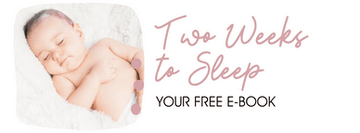
Receive product and services updates, promotional offers and other marketing communications based.


